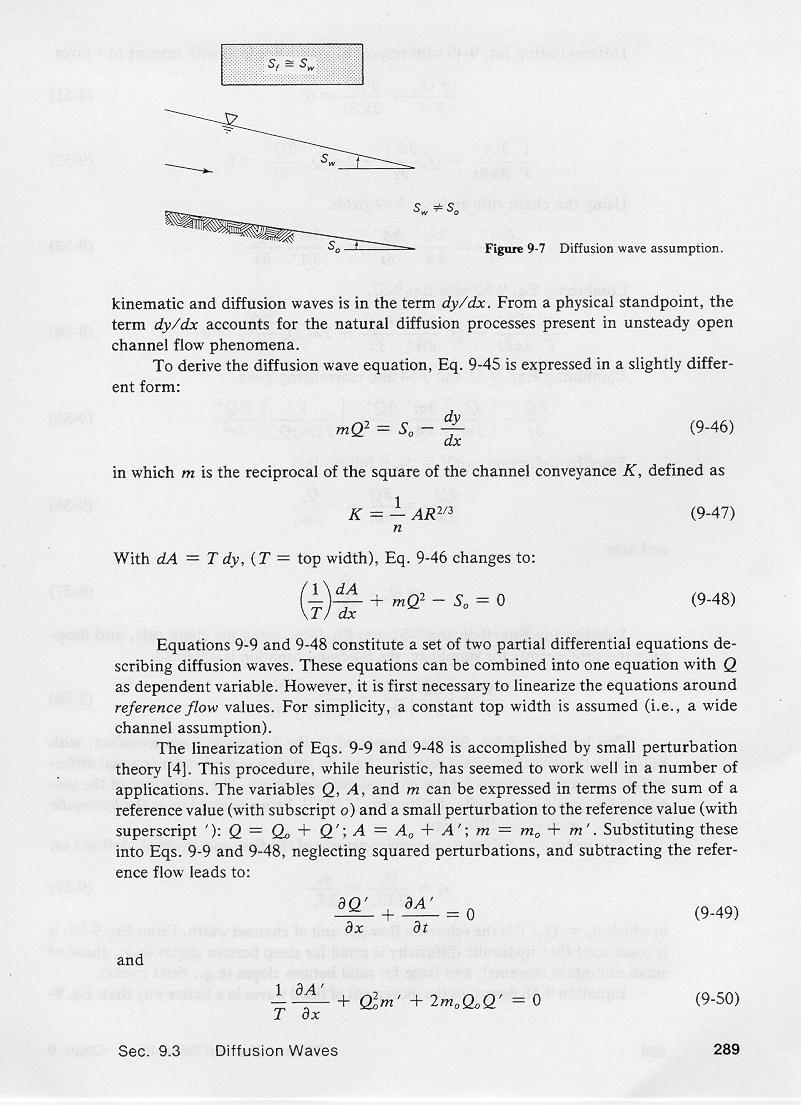|
ENGINEERING HYDROLOGY: CHAPTER 094 - DIFFUSION WAVES
1. DIFFUSION WAVE EQUATION
1.01
Kinematic wave theory can be enhanced by allowing a small amount of physical
diffusion in its formulation.
1.02
In this way, an improved type of kinematic wave can be formulated,
that is, a kinematic wave with diffusion, for short, a diffusion wave.
1.03
A definite advantage of the diffusion wave is that it includes the diffusion effect
which is present in most natural unsteady open-channel flows.
1.04
The kinematic wave equation is derived using a statement of steady
uniform flow in lieu of momentum conservation.
1.05
On the other hand, the diffusion wave equation
is derived using a statement of steady nonuniform flow.
1.06
In other words, in the diffusion wave, the friction slope is equal to the water surface slope,
rather than the bottom slope.
1.07
This leads to:
1.08
1
| Q = |
| A R2/3 [So - (dy/dx)]1/2
|
n
|
1.09
in which So is the bottom slope, and dy/dx
is the flow depth gradient.
1.10
The difference between kinematic and diffusion waves is in the flow depth gradient.
1.11
From a physical standpoint, the flow depth gradient accounts
for the natural diffusion process present in unsteady open-channel flow.
1.12
To derive the diffusion wave equation, the previous equation is expressed as follows:
1.13
1.14
in which m is the reciprocal of the square root of the conveyance K, defined as follows:
1.15
1.16
With:
1.17
1.18
This equation converts to:
1.19
1.20
The equation of continuity is:
1.21
1.22
These two equations constitute a set of two partial differential
equations describing diffusion waves.
1.23
For certain applications, these equations can be combined into one
equation with discharge Q as the dependent variable.
1.24
After appropriate linearization, the diffusion wave equation is obtained:
1.25
∂Q dQ ∂Q Qo ∂2Q
∂t dA ∂x 2TSo ∂x2
|
1.26
The left-hand side of this equation is recognized as the
kinematic wave equation.
1.27
The right-hand side is a second-order term
that accounts for the physical diffusion effect.
1.28
The coefficient of the diffusion term has the units
L2/T.
1.29
This coefficient is referred to as Hayami's hydraulic diffusivity.
1.30
The hydraulic diffusivity is a characteristic of flow and channel, defined
as follows:
1.31
1.32
in which:
1.33
1.34
is the reference flow per unit of channel width.
1.35
The hydraulic diffusivity is directly proportional to the unit-width discharge
and inversely proportional to the channel slope.
1.36
Thus, diffusion is small for steep slopes
and large for mild slopes.
1.37
Steep slopes are those of mountain streams, while mild slopes are typically those of
large basins.
1.38
The diffusion wave equation describes the movement of flood waves
in a better way than the kinematic wave.
1.39
It falls short of describing the full momentum effects, but it does
physically account for wave attenuation.
1.40
The diffusion wave equation is a second-order differential equation
of the parabolic type.
1.41
It can be solved analytically, leading to Hayami's diffusion analogy of flood waves.
1.42
It can also be solved numerically, using a scheme suited to parabolic equations
such as the Crank-Nicolson scheme.
1.43
An alternate approach is to match the numerical diffusivity of the physical problem
with the numerical diffusivity inherent in the Muskingum method.
1.44
This approach is the basis of the Muskingum-Cunge method.
2. APPLICABILITY
2.01
Most flood waves have a small amount of physical diffusion.
2.02
Therefore, they are better approximated by the diffusion wave rather than by
the kinematic wave.
2.03
For this reason, diffusion waves apply to a much wider range of practical
problems than kinematic waves.
2.04
When the diffusion wave fails, only the dynamic wave can properly
describe the translation and diffusion of a flood wave.
2.05
However, the dynamic wave is very strongly dissipative, especially for
flows well in the subcritical regime.
2.06
In practice, most flows are only mildly diffusive; therefore, they
are subject to modeling with the diffusion wave.
2.07
A diffusion wave satisfies the following dimensionless inequality:
2.08
2.09
in which tr is the time-of-rise of the inflow hydrograph,
So is the bottom slope, do is the average flow depth,
and g is the gravitational acceleration.
2.10
The greater the left-hand side of this inequality, the more likely that the
flood wave is a diffusion wave.
2.11
In practice, a value of M = 15 is recommended for general use.
4.12

Narrator: Victor M. Ponce
Music: Fernando Oñate
Editor: Flor Pérez
Copyright © 2011
Visualab Productions
All rights reserved
| 